聚醚醚酮 (PEEK) 转移材料在 PEEK 与钢接触时的特性
DOI:10.1016/j.triboint.2019.02.028
文章链接:
https://www.sciencedirect.com/science/article/abs/pii/S0301679X1930091X
摘要:
聚醚醚酮(PEEK)是一种高性能聚合物,可在无润滑条件下替代某些运动部件的金属。在摩擦过程中,PEEK被转移到配合面。通过对PEEK磨损过程、接触温度和摩擦发生的原位观察,以及FTIR和拉曼光谱异位分析,研究了PEEK转移膜在钢和蓝宝石上的形成和性能。我们的结果表明,单独的摩擦加热可能不足以产生在转移材料中观察到的PEEK降解。在摩擦过程中观察到的摩擦,连同机械剪切,可能会促进自由基的产生和PEEK的降解,进而影响PEEK转移膜的性能和聚合物-金属摩擦对的性能。
关键词:聚醚醚酮;转移膜形成;原位摩擦等离子体;原位接触温度
Abstract:
Polyetheretherketone (PEEK) is a high performance polymer that can be an alternative to metal for some moving components in unlubricated conditions. During rubbing, PEEK is transferred to the counterface. The formation and properties of PEEK transfer films on steel and sapphire are studied by in-situ observations of PEEK wear process, contact temperatures and triboemission, as well as FTIR and Raman spectroscopies ex-situ. Our results suggest that frictional heating alone may not be sufficient to generate PEEK degradation observed in the transfer materials. Triboplasma observed during rubbing, together with mechanical shear, may promote generations of radicals and degradation of PEEK, which subsequently influence the properties of PEEK transfer film and performance of polymer-metal tribopair.
Keywords:Polyetheretherketone;Transfer film formation;In situ triboplasma;In situ contact temperature
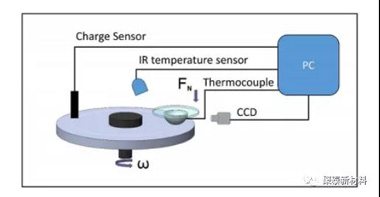
图1摩擦测试实验装置示意图
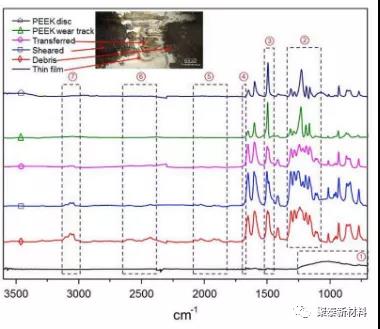
图2 原始PEEK圆盘、PEEK磨损轨迹和钢上各种PEEK转移材料的FTIR光谱。
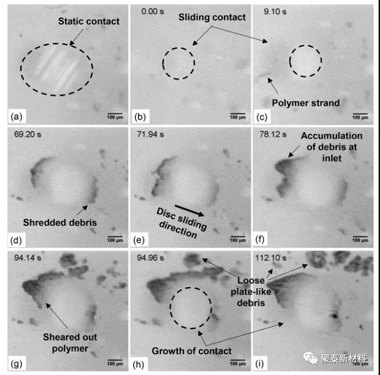
图2 50Hz下PEEK蓝宝石接触成像的快照,显示了原位PEEK的磨损过程
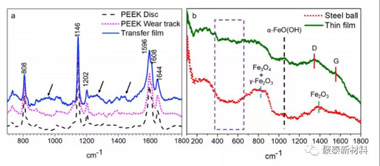
图2 干净钢球、原始PEEK圆盘、PEEK磨损轨迹以及钢磨损疤痕上的转移膜和薄膜的拉曼光谱(785nm激发)
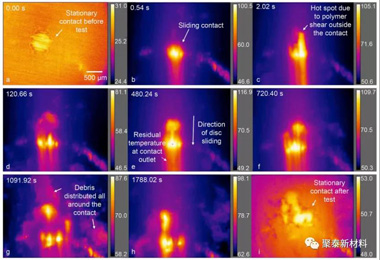
图3使用红外成像进行原位温度测量的快照
结论:当 PEEK 与蓝宝石和钢摩擦时,它会在我们的测试条件下转移到接触面上。我们通过磨损过程、接触温度和摩擦等离子生成的原位监测来检查PEEK 转移层的形成。当摩擦开始时,PEEK表面被钢球刮擦的凹凸不平,其中一些材料以接触碎片的形式被夹带和剪切,同时发生材料转移。
PEEK转移材料在磨损疤痕上的化学性质不同于原始PEEK的化学性质。在较厚的转移膜和反面之间形成的薄膜主要是无定形碳质材料。其他PEEK转移材料的FTIR结果表明PEEK 链的断裂发生在醚和酮基团的不同位置。此外,观察到芳香环的打开、取代、交联以及结晶度的损失和环的共面性。碳酸盐和羧酸可以通过酸碱反应形成并与钢或蓝宝石表面反应,形成薄而坚固的转移膜。
原位IR热成像显示标称接触温度低于 PEEK的Tg,即使局部温度因夹带碎片而升高。拉曼研究的结果支持接触温度 (100-120°C) 低于 PEEK 的 Tg。因此,单独的接触温度可能不足以产生观察到的 PEEK 降解。钢磨痕上薄膜上脆性裂纹的存在也表明变形温度可能相对较低并且薄膜可能已暴露于紫外线照射。
摩擦表面所经历的剪切导致它们的摩擦带电。结果在摩擦过程中产生摩擦原。这种摩擦原具有足够的能量,与机械剪切一起,可以引起断链并产生自由基。这会促进转移膜的形成并导致 PEEK 的交联和降解。我们的结果表明,机械剪切、摩擦加热和摩擦等离子都有助于摩擦表面上 PEEK 转移材料的形成和性能。牢记产生紫外线等离子体的可能性,未来聚合物和聚合物复合材料的设计应考虑表面带电的可能性及其对转移膜形成和降解的潜在影响。
Conclusions:
When PEEK is rubbed against sapphire and steel, it is transferred to the counterfaces under our test conditions. The formation of PEEK transfer layers was examined by in-situ monitoring of the wear process, contact temperature, and triboplasma generation. As rubbing starts, the PEEK surface is initially ploughed by the asperities of the steel ball. Some of these materials are entrained and sheared in the contact. Debris form, as well as materials transfer occurs.
The chemistry of PEEK transferred materials on wear scars differ from that of pristine PEEK. The thin film, which are formed between the thicker transfer films and the counterface, is mainly amorphous carbon aceous materials. FTIR results of other PEEK transferred materials suggest scission of PEEK chains occurs at various positions in the ether and ketone groups. In addition, opening of the aromatic rings, substitution, crosslinking, along with loss of crystallinity, and co-planarity of the rings are observed. Carbonate and carboxylic acid may form and react with steel or sapphire surface through an acid-base reaction, forming the thin and robust transfer films.
In-situ IR thermography shows that the nominal contact temperature is below PEEK Tg even though local temperature is raised by the entrainment of debris. Results from Raman studies support that the contact temperature (100-120°C) is below the Tg of PEEK. Hence contact temperature alone may not be sufficient to generate the PEEK degradations observed. The presence of brittle cracks on the thin film on the steel wear scar also suggests that the deformation temperature may be relatively low and the film may have exposed to UV irradiation.
The shear experienced by the rubbing surfaces leads to their triboelectrification. As a result, triboplasma is generated during rubbing. This triboplasma has sufficient energy, which together with the mechanical shear, can cause chain scission and generate radicals. This promotes transfer film formation and leads to crosslinking and degradation of PEEK. Our results show that mechanical shear, as well as frictional heating and triboplasma all contribute to the formation and properties of the PEEK transferred materials on the rubbing counterface. Keeping the possibility of UV plasma generation in mind, the design of future polymer and polymer composites should take the possibility of surface charging and the potential effect it may have on transfer film formation and degradation into considerations.
聚泰新材料期待为您提供优质的产品及服务!
电话:0512-65131882
手机:133 2805 8565

